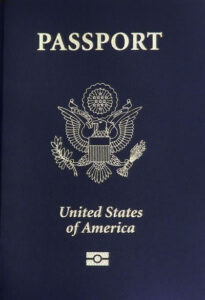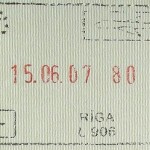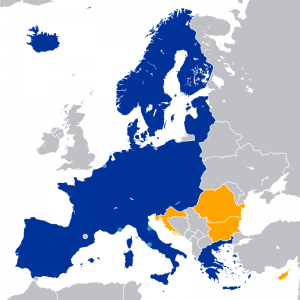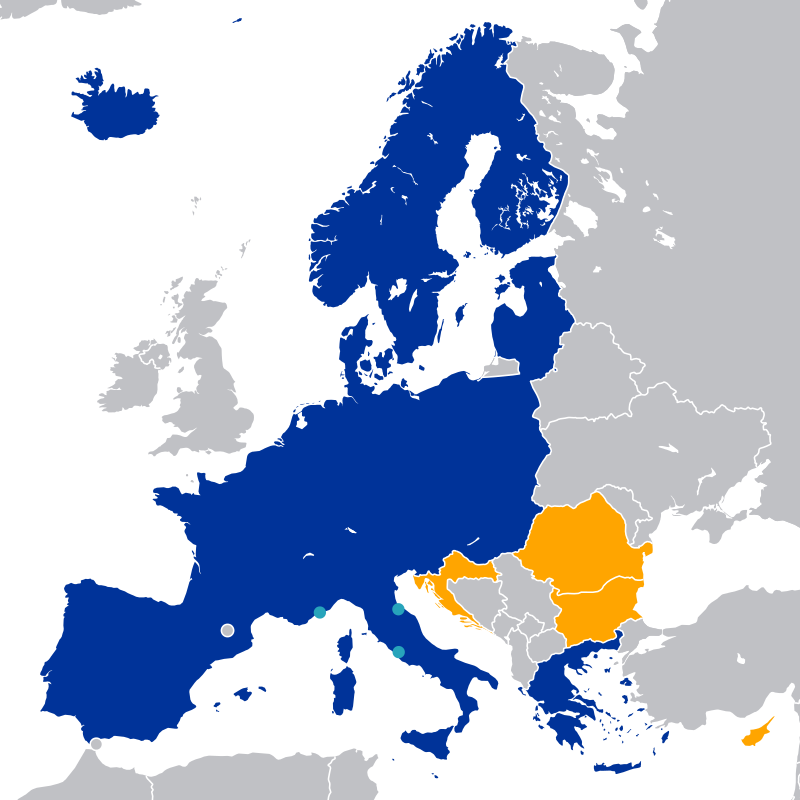
We thought we had figured out a legitimate way to stay in Europe for six months, when a normal visa lasts just 90 days. We just discovered we were wrong…and so far wrong we could have ended up in an Estonian jail.
Not many years ago, as an American or most other foreigners, you could quite easily stay in Europe for as long as you wanted. Despite the rules limiting stays to 90 days, you could leave one country and come back a few days later, thereby starting your 90-day clock all over again.
 Then the rules were codified by the EU in the Schengen Agreement (see the list of Schengen countries below). The agreement, named for the small town in Luxembourg where it was created, established a common border across European countries, somewhat like the United States, as well as the short-stay rule (or the 90/180 rule, as it’s known): a visitor can only stay for 90 days out of a period of 180 days. You can’t just cross the border to a non-Schengen country and return to start a new 90 day period; you have to be away for half the time.
Then the rules were codified by the EU in the Schengen Agreement (see the list of Schengen countries below). The agreement, named for the small town in Luxembourg where it was created, established a common border across European countries, somewhat like the United States, as well as the short-stay rule (or the 90/180 rule, as it’s known): a visitor can only stay for 90 days out of a period of 180 days. You can’t just cross the border to a non-Schengen country and return to start a new 90 day period; you have to be away for half the time.
The result was that a visit longer than 90 days pretty much required a long-stay visa (Type D), via application to a specific country. The typical reasons to grant long-stay visas were approved work, school study in a formal program, or re-uniting with family. Lingering tourists weren’t exactly welcome. That was partly because they tended to be young and unfunded. But even older ones were suspect as potentially dependent on medical systems or aid which they never paid for as workers and citizens. Now, at least, some of the EU countries – like Italy, Portugal, France – seem quite open to long-term stays for retirees with a nest-egg.
Long-term visas can last six or twelve months, depending on the country, and your acceptability can vary accordingly, as does the ease of renewing. Generally, each country wants you to prove you have sufficient money, health insurance, funds for a ticket out, and a place to live – plus no record of being a criminal or worse. One wrinkle is that in visiting other Schengen countries, the short-term stay rules still apply – so you’re not legit if, say, you have a long-term visa from Italy, but want to stay in Germany more than the 90/180 rule would allow.
So, in trying to stay for a long time in Europe without a long-term visa, we’ve needed to do some careful math, what with irregular days in a month, exits and entrances, plus the counting of entry and exit days as full days out of the 90 allowed. For several years now we’ve been using a spreadsheet to manage our stays because overstaying is various forms of bad news. Miss by a few days and maybe a forgiving immigration official will let it pass. Miss by a lot and you could end up in jail, fined or banned from the EU forever. Plus, you’re potentially at risk of traveling anywhere else since your passport is stamped as an “overstayer.”
Our scheme to stay for six months in Estonia without a long-term visa was not risky, we thought, but a legitimate wrinkle in the Schengen rules. We had found a number of traveler resources online that confirmed our approach too. What we didn’t realize is that the “mathematics” of the rule had changed in a subtle, but crucial way.
Here’s what we thought would work (using a simplified calendar of 30 days per month to make the illustration easier to follow)
After nearly four months out of the EU/Schengen, we passed through Paris on 20 December, then departed Paris on 24 December – a 5 day stay per the Schengen rules. By our calculation, we had 85 days left to use on our 180-day clock ending on 20 June 2016. We planned to return to the EU on 20 March 2016, stay till 15 June (85 days). Then we would leave the EU to visit Russia for 15 days and return on 1 July.
The math: total stay in EU before the clock ran out on 20 June would be 90 days (85 in Estonia and 5 in Paris). Our new 180-day clock would begin 1 July and last until the end of December.
OK, we’re good!! And now we can spend 90 days more in the Schengen EU on that new clock!
Not so fast… The math above is impeccable. But we – and our online sources – were all wrong, as of 18 October 2013.

From then on, the math changed: the Schengen time period does not start from the date of first entry into the EU, but is figured BACKWARD from when you exit. “Huh?” we said at first, when the Estonian embassy pointed this out, in response to our might-as-well-check inquiry. And, huh, reading the new rule again and again, until we finally understood what the new math was telling us. (See the posted rule notice at the end.)
The 180 days are no longer a fixed point starting at date of entry, but a movable checkpoint. When you depart the Schengen EU, the visa check counts 180 days backwards from the exit date. If you’ve only stayed 90 days during that period, you’re good. We would definitely not have been.
Here’s why:
We were just fine leaving the EU on 15 June for Russia. For the 180 day period back to 15 December 2015, we spent 90 days in the EU. The new math works out the same.
However, after innocently returning on 1 July, then staying until, say, 30 September, we put 90 days on what we think is our new clock. At exit border control, a stern-faced immigration official does the new math: 180 days backwards from 30 September is 1 April. Since then we spent 85 days in Estonia, were gone for 15 days, and then returned for …WHAT?…90 days! That’s 175 days in the last 180. Go to jail. Go directly to jail. Do not pass GO.
Start mastering Estonian prison songs, like the Estonian Song of Liberation during the Soviet era:
Your Birds will sing Sleep to Me,
flowers will bloom from My Ashes,
My Fatherland, My Fatherland!
The bottom line now is that you get 90 days tops in any movable 180 day period. No wrinkle.
After letting us in on the new math, thankfully before requiring prison time, the Estonians were quite wonderful about our interest in a six month long-term stay among the Estonians, Latvians, Lithuanians and Finns. With a side trip to St. Petersburg. They told us we need to go to Riga after we arrive and apply at the consulate there for a long-term visa. We do expect we will pass their review.
But, just in case we only get 90 days, we’ll also come with a backup plan – outside of Schengen.
—-
1. A side note on the new calculation:
A footnote to the rule is that, after Russia, we could have returned and stayed legitimately for 5 days, because our December stay in Paris was back far enough to drop out of the calculation. Say we departed the EU on 5 July. The smiling immigration official does the math. 180 days backward from 5 July is 5 January, so your 5 days in Paris don’t matter. You spent 85 days here in that span, left, returned and then another 5. So you’re good. See you in about 90 days!!
2. The Modified 90/180 Day Rule for Schengen countries:

On 18.10.2013 shall enter into force the modifications to the Schengen Borders Code and Visa Code, which modify the principles of calculating the period of stay in the Schengen area on the basis of multiple short-term visa.
Starting from 18.10.2013, upon checking of the authorised period of stay, the 180-days period preceding the date of checking shall be counted backward. Different from the previous regulation, the periods shall not be counted starting from the first entry to the state/Schengen area, but the period is movable and it depends on the date of checking the visa. If the person has stayed in the Schengen area during the 180-day backward counting period, then the number of days stayed shall be discounted from the number of days authorised by the visa. The dates of stay shall include only those dates, which will remain in the 180-day backward counting period. Upon counting the duration of stay on the territories of Member States, the stay on the basis of residence permit or long-term visa shall not be taken into account.
Whereas the 180-day period shall no longer depend on the first entry to the state/Schengen area, but the 180-day backward counting period is movable, then the persons travelling on the basis of visa must be careful and must watch that they will not stay on the territories of Member States during the 180-day period longer than the period of stay authorised by the visa.
(Source: http://vm.ee/en/news/modifications-schengen-borders-code-and-visa-code-shall-enter-force)
Note that Schengen provides a short-stay calculator that is a bit confusing to figure out, but otherwise works for real 28, 30, 31 day months.
http://ec.europa.eu/dgs/home-affairs/what-we-do/policies/borders-and-visas/border-crossing/schengen_calculator_en.html
3. What’s in, what’s out of Schengen:
Not all EU members are in Schengen, e.g. England, and not all Schengen countries are EU, e.g. Norway. Other countries like Croatia should be included in the future, if the Schengen treaty holds under the various pressures the EU is confronting, including refugee immigration.
| Austria | Liechtenstein |
| Belgium | Lithuania |
| Czech Republic | Luxembourg |
| Denmark | Malta |
| Estonia | Netherlands |
| Finland | Norway |
| France | Poland |
| Germany | Portugal |
| Greece | Slovakia |
| Hungary | Slovenia |
| Iceland | Spain |
| Italy | Sweden |
| Latvia | Switzerland |
Image sources:
Schengen Map from Wikimedia by Rob984 – Derived from File:Schengen Area.svg, CC BY-SA 4.0, https://commons.wikimedia.org/w/index.php?curid=42820992. Exit stamp by LVpassportstamp.jpg: Fernão Raposo Naitoderivative work: Perreyd – This file was derived from LVpassportstamp.jpg:, CC BY-SA 3.0, https://commons.wikimedia.org/w/index.php?curid=20145382. Patarei prison By Jon Shave-Flickr: Patarei Prison, Tallinn, CC BY 2.0, https://commons.wikimedia.org/w/index.php?curid=13352415.






